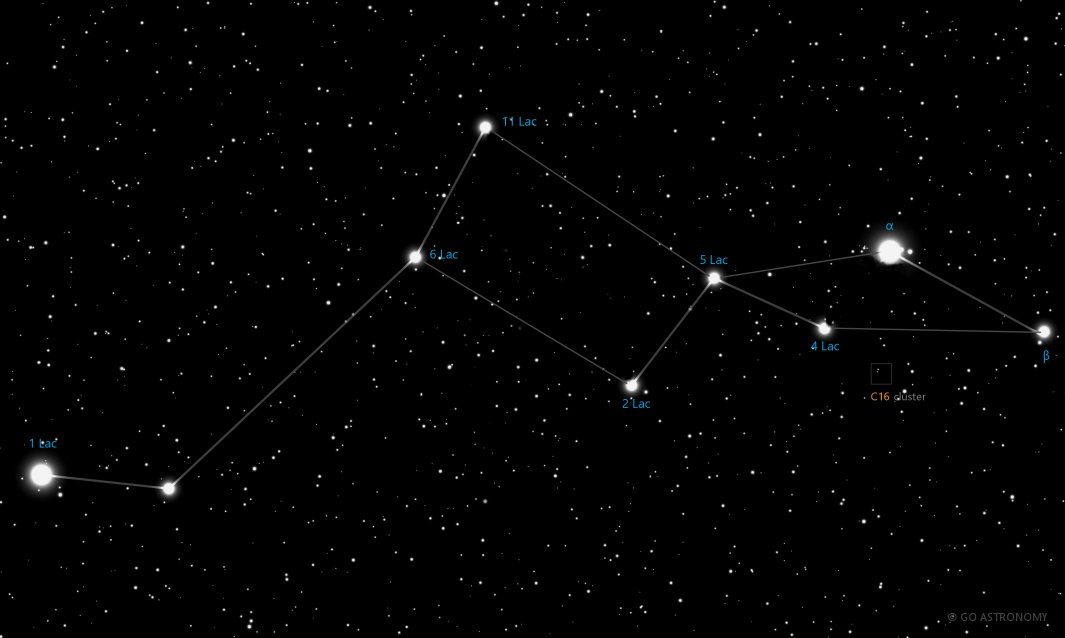Lacerta, the Lizard (Lac)
(luh-SER-tuh)
The Northern constellation of Lacerta, the Lizard, is best viewed in Fall during the month of October.
Lacerta is the 68th largest constellation. It's brightest star is Alpha Lacertae at magnitude 3.76. The boundary of the Lacerta constellation contains 3 stars that host known exoplanets.
- Pronunciation:
- luh-SER-tuh
- Meaning:
- Lizard
- Genitive:
- Lacertae
- Abbreviation:
- Lac
- Constellation Family:
- Perseus
- Hemisphere:
- Northern
- Quadrant:
- NQ4
- Visibility:
- 90° N - 40° S
- Best viewing month*:
- October
- Area:
- 201 sq. degrees
- Size:
- 68th largest
- Right Ascension (avg):
- 22h 31m
- Declination (avg):
- 45°
- Brightest star:
- Alpha Lacertae (3.76)
- Stars with planets:
- 3
- Messier objects:
- |
Brightest Stars in Lacerta
The 10 brightest stars in the constellation Lacerta by magnitude.
- Star
- Magnitude
- Spectral class
- Alpha Lacertae (α Lac)
- 3.76
- A1V
- 1 Lacertae (1 Lac)
- 4.14
- K3III
- 5 Lacertae (5 Lac)
- 4.34
- M0II
- Beta Lacertae (β Lac)
- 4.42
- G9III
- HD 211073
- 4.5
- K3III
- 11 Lacertae (11 Lac)
- 4.5
- K3III
- 6 Lacertae (6 Lac)
- 4.52
- B2IV
- 2 Lacertae (2 Lac)
- 4.55
- B6V
- 4 Lacertae (4 Lac)
- 4.55
- B9Iab
- 9 Lacertae (9 Lac)
- 4.64
- A8IV
Double Stars in Lacerta
These are the brightest and easiest-to-find double, triple, and quadruple star systems in the constellation Lacerta. Also see all star clusters.
- Star system
- Magnitudes
- Type
- 8 Lacerta
- 5.7, 6.3
- double
Galaxies in Lacerta
The most notable galaxies in the constellation Lacerta. Also see all galaxies.
The Lizard Constellation
Lacerta, Latin for lizard, is a small, faint constellation located in the northern celestial hemisphere. Despite its low profile in terms of brightness, Lacerta is rich in celestial objects and contributes to our understanding of the universe.
Historical Overview
The constellation Lacerta was introduced by the Polish astronomer Johannes Hevelius in the 17th century. It's one of the 88 constellations officially recognized by the International Astronomical Union (IAU). Unlike many of the more ancient constellations, Lacerta does not have any myths associated with it. The term Lacerta was coined by Hevelius, who intended to fill a gap between the constellations of Cygnus and Andromeda with this small and 'insignificant' constellation.
Location and Main Features
Lacerta is nestled in between the constellations of Andromeda, Cygnus, Cepheus, and Pegasus in the fourth quadrant of the northern hemisphere (NQ4). It can be seen at latitudes between +90? and -40?. It is a small constellation, occupying an area of 201 square degrees, ranking it 68th in size among the other 87 constellations.
Major Stars
The constellation of Lacerta is relatively faint with no stars brighter than the 4th magnitude. The brightest star in Lacerta, Alpha Lacertae, is a main-sequence star of spectral type A1V with an apparent magnitude of 3.77, located about 102 light-years away from Earth. Alpha Lacertae is about twice the size of our sun and approximately 31 times more luminous.
The second-brightest star, Beta Lacertae, is a giant star of spectral type G8III. It is located approximately 170 light-years away and has an apparent magnitude of 4.43.
The constellation also hosts the prototype of a class of variable stars, the RV Lacertae variables. These are giant binary stars that vary in brightness as the stars eclipse each other.
Deep Sky Objects
While lacking in bright stars, Lacerta is home to several deep-sky objects of interest. It houses the prototypical blazar BL Lacertae, a type of active galactic nucleus. This object varies in brightness and was originally thought to be a variable star.
Another intriguing object within Lacerta is the open cluster NGC 7243. Located approximately 2,800 light-years away, this cluster spans 21 light-years across and is estimated to be roughly 100 million years old.
Observation
The constellation Lacerta is best observed during autumn, particularly in the month of October. Due to its location in the northern celestial hemisphere, it can be seen from most locations in the northern hemisphere and the northern regions of the southern hemisphere. However, because of its relative faintness, it is best observed from a location with minimal light pollution.
Lacerta in Modern Astronomy
Even though Lacerta might not be the most striking constellation, it holds a unique place in modern astronomy. As a home to the prototype of a class of variable stars and deep-sky objects, it offers a wealth of research opportunities. The study of the blazar BL Lacertae, for instance, provides insights into some of the most energetic phenomena in the universe.
* Constellation shown for northen hemisphere skies. For the southern hemisphere, constellations appear rotated 180 degrees (upside-down and left-right reversed) from what is shown. Remember that seasons are reversed too - summer in northern latitudes is winter in southern latitudes.
** Circumpolar constellations are visible year-round in the hemisphere listed (and not at all in the opposite hemisphere).





